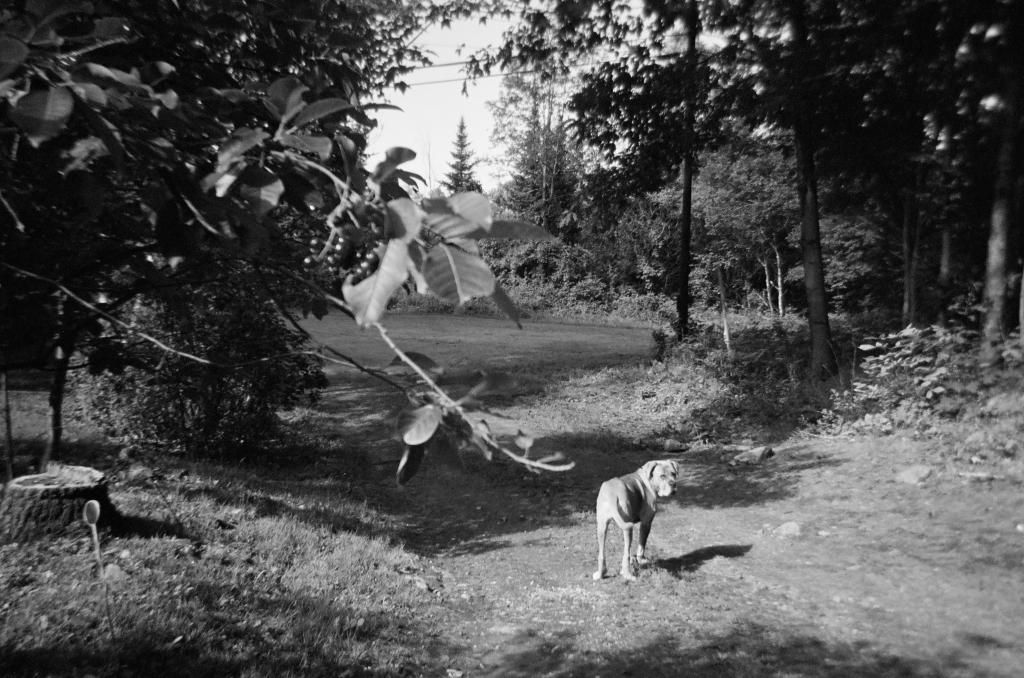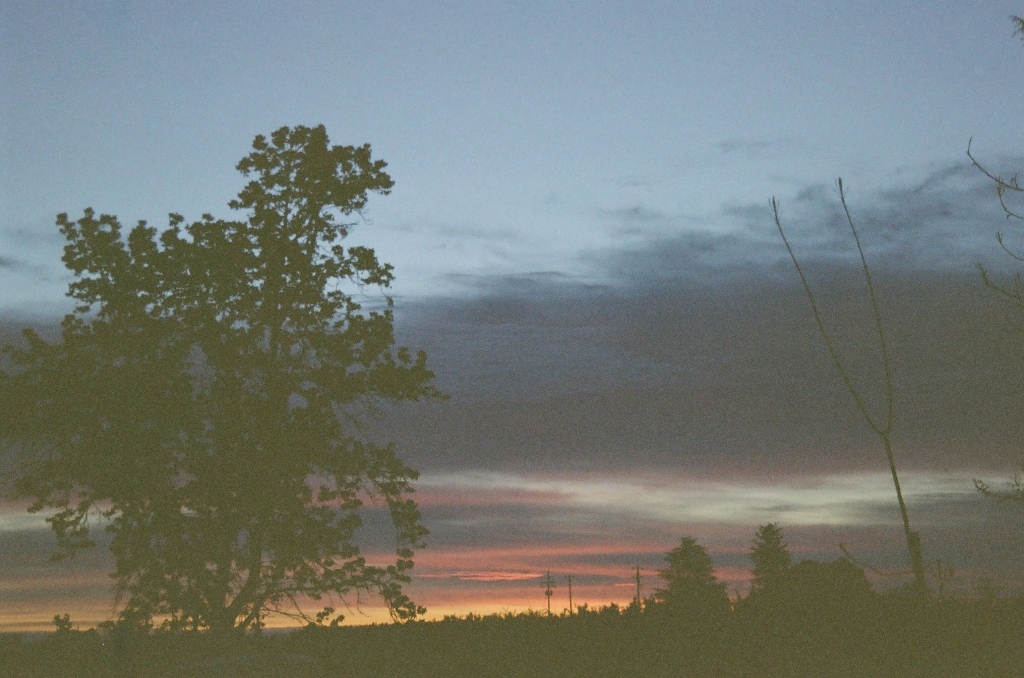We lost a lot of trees while we were gone. Not small ones. The storms that blew through New England while we were down south, soaking up the sun on tour, wrecked our yard. We were fortunate– they didn’t land on the house, the shed, my studio. But it was no small destruction. A huge one went down, taking a few smaller ones with it. The trees that remain around the fallen are still bent at an angle from which I’m not sure they’ll ever recover.
I have not yet spent enough time in my home or on this land to be able to distinguish if they were at all useful or important to our two-and-a-quarter acre ecosystem. I couldn’t even tell you their specific classification. Mostly, we lost pines. We’ve been told that’s common here– pines don’t have tap roots. They’re real pushovers. Oaks, I am told, maples– the big deciduous types not only have a taproot, but are a flat replica of themselves below ground. They spread wide like the base of a wineglass, their roots luxurious in space, deepening further with their extended tap root finger marking their spot. Which is why they are more likely to survive the heavy winds of a New England storm.
The big tree that fell was this kind. A maple.
It created a small mountain of limb and trunk and branch, at which we numbly stared from our bedroom window. The immensity of this aftermath was trumped only by the loss of our lone and favorite Blue Spruce that went down next to the driveway– a household favorite– ball and all headlong upon our entry.
Trees have always been an obvious metaphor for me. As a kid, my parents called me a Treehugger, a gentle nag at my penchant for spending long mornings and afternoons in the woods around our cabin, coming back with a list of animals I’d seen, plants I’d identified, and rocks I thought pretty enough to bring home so that they lined the windowsills. I was the one who stayed indoors during deer season, gluing together pompoms and pipe cleaners and smearing them with paint rather than smearing my hands with the blood of the deer the rest of the family hunted– the deer that would feed us the rest of the winter. The venison I had no stomach for as I got closer to adulthood, as grateful as I was to their sacrifice.
“Our little Treehugger,” my dad would say as he came back in for lunch to find me melting wax onto a finished art project. It didn’t bother me, as I knew I didn’t actually hug trees… very often. It was a shorthand for some sort of understanding about who I am. A way of distinguishing some core belief I contained that was apparent to everyone, that didn’t seem to conflict with what I believed about myself enough to protest. And from there, I grew into a folk singer– treehugger adjacent, if not synonymous. In a sorting and forgiving of my childhood story’s hurt, I now have a maple tree– the maple from the backyard of my childhood home– tattooed up my arm and on to my right shoulder blade coming just short of my spine. A tree, at last, to hug me back.

And then I have my Circle of Trees.
Annie reentered my life in 2020, after a long hiatus of growing apart and moving on. We did long distance yoga and book club and grew to touch base almost every day. A happenstance of the pandemic, and of lowering our defenses. We had a third, too, but she fell away like a pine. Annie and I persisted, and came across a book that would help define us– The Dance of the Dissident Daughter by Sue Monk Kidd. It’s a book of faith, and a book of losing faith, and a book that took two women who invited a third– not long after a fourth– and grounded us firmly in each other’s path. The passage that has become our own shorthand is that of the Circle of Trees, wherein Kidd describes her women folk as a circle in the forest, in which each of them are a tree. They are rooted in each other’s soil, growing separately but sharing sun and shade and nutrients– sharing the earth beneath them as a way of communicating and connecting. It’s a metaphor that makes these hapless sensitive spirits feel stronger, less alone, and shielded from even the strongest New England storm.
The pine who blew down, she eventually grew back. Tentatively at first, then extraordinarily fast. For a minute, I mistook her for a maple. An oak. An ash or a birch or even a cottonwood. But a pine, however beloved, is still a pine. And at the end of last year, a wind took her out again from our circle. Not even a strong one. Just a low breeze on an ordinary day. And like that, she was laid out, rocks falling from the ball of her roots, though still casting those rocks in our direction.
“We are one tree less,” Annie has been saying since. The ache of it radiates from the truth, and I have still not fully healed from the loss. It is one thing to have a tree blown away. It is another for her to pick up her roots and leave. The unnaturalness of this departure crowds out my acceptance.
So when we came home last week to find our trees down, I was submissive to the metaphor again. I strained my eyes against the barrenness of the large tree’s absence, and covered my head with my blanket at 7:20 in the morning, when the sun peers in through a window that this tree used to block from glaring directly on my head. I begrudge her more. And then, I decided she was not a pine at all, not helpless and unsure and unable to resist. She really was a maple. Only a hardwood could do this much damage– and take so many down with her– when she uprooted and decided to fall. This was not the result of a light wind, but an accumulation of storms over time. One tree less, maybe, but a Circle of Trees affected. She’d been releasing her roots before someone else ever came to push her out.

There is a myth about hardwoods, that their root system below is actually a mirror image of themselves– that they go as deep as they do tall, each branch above replicated by one below. This is not true. In fact, it is near impossible for a tree to do so, to dig so deep, and still receive the nutrients it needs to survive. It must grow outward at the base. We are never exactly who we are above as we are deep within, no matter how hard we try. Always, we must spread our roots out toward others to steady ourselves. I am no exception. I can only hope my taproot is not formed of anger, but of something more sustainable. I can only hope I keep reaching out.
I have been finding small miracles beneath the wreckage. We have made friends with our neighbor, now– a handyman we were certain hated us, but turned out only not to know us at all. He came with machinery to clear out the large slabs that would’ve taken us a couple weeks to clear ourselves– slabs he’ll mill and use for his own work. He left us neat piles about the property– fodder for a bonfire we intend to invite our friends to this month before we leave again for our next tour. And also this: in late fall, we planted a northern tart cherry tree. It sits in the back yard, and was fully forgotten in the felled tree derelict. My Someone came in after the first assessment, looking hopeful.
“Everything is okay?” I asked.
“Well, no– we still lost a lot of trees, but guess what?” he paused for an answer, and on receiving none, continued, “I lifted up some of the limbs and found our cherry tree.”
I sagged, feeling myself drowned beneath a heap of limbs.
“No,” he said, reading me, “it’s okay! I think it’s going to be just fine! I straightened it up, and it looks to be in good shape.”
What luck. What damn dumb luck. Of all the pines, the big maple, the creature casualties– the littlest, not yet one year with us, held on for hopes of spring.
Sometimes the trees that have grown so big and strong around us, while destructive in their exit, aren’t as meaningful as the ones we are planting right now, the ones we are tending to. These little ones that may even one day bear fruit. Literal fruit. Sometimes, when those big maples fall, you’ll still notice the big gap like a toothy leer, but then you’ll suddenly remember what’s important, and with a quick assessment, can save what’s beneath it. And the sturdiness of a cherry tree in its first winter will shock you back into doing the good work of putting your hands to the soil– continuing to reach out. Of unexpected new neighbors. Of the reassurance of old friends.
Sometimes one less tree means a little more light for the rest of it. Some of it blinding in the morning, willing you to get up and see how it also shines directly down on a winter day to a strapping young cherry tree, waiting to be born.
So good. I think of some of the classes I took for my degree in Wildlife Ecology. A tree like your Maple coming down and open up the tree canopy for new vegetation. Amazing stuff! Thanks Mallory!!
Oh, wow! That’s a metaphor if I’ve ever heard it. Perfect correlation, thank you, John! Perhaps you can come help me identify the rest of these trees sometime.
This is a very moving piece Mallory. It’s also very balanced with sorrow and hope. Some sorrows we keep with us as you will always miss the big maple. But the new light lets one hope. I felt very many emotions as I read through this piece. Thanks for sharing
Thank you for reading, Kris! You’ve been so elemental in this particular process, and I appreciate you coming all the way through it with me.
This was a great read! ✨👏 Oh How I miss my old trail of trees, mostly Maples, They have a calming way when your walking the woods. Thanks for sharing you inspire so many! 💗💗